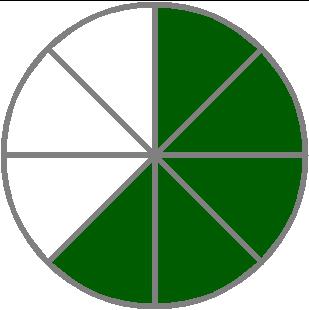The main property of fractions. Rules. The main property of an algebraic fraction
Speaking of mathematics, one can not help remembering fractions. A lot of attention and time is devoted to their study. Remember how many examples you had to decide in order to learn certain rules of working with fractions, as you memorized and applied the main property of the fraction. How many nerves were spent to find a common denominator, especially if the examples had more than two terms!
Let's remember what it is, and a little refresh in the basic information and rules of working with fractions.

Definition of fractions
Let's start, perhaps, with the most important thing - the definition. A fraction is a number that consists of one or more parts of a unit. A fractional number is written in the form of two numbers separated by a horizontal or slash. In this case, the upper (or first) is called the numerator, and the lower (the second) is called the denominator.
It is worth noting that the denominator shows how many units are divided, and the numerator is the number of shares or parts taken. Often fractions, if they are correct, are less than one.
Now let's look at the properties of these numbers andThe basic rules that are used when working with them. But before we deal with such a notion as the "basic property of rational fraction", let's talk about the types of fractions and their features.
What are the fractions
Several types of such numbers can be distinguished. First of all, these are ordinary and decimal. The first represent the kind of recording of a rational number we have already indicated using a horizontal or oblique stroke. The second kind of fractions is denoted by the so-called positional record, when the whole part of the number is first indicated, and then, after the comma, the fractional part is indicated.
Here it is worth noting that in mathematics equallyBoth decimal and ordinary fractions are used. The main property of a fraction in this case is valid only for the second variant. In addition, in regular fractions, the correct and incorrect numbers are distinguished. The first numerator is always less than the denominator. We also note that such a fraction is less than unity. In the wrong fraction, on the contrary, the numerator is greater than the denominator, and it itself is greater than one. Thus from it it is possible to allocate the integer. In this article, we will consider only ordinary fractions.

Fraction Properties
Any phenomenon, chemical, physical ormathematical, has its own characteristics and properties. Fractional numbers have not become an exception. They have one important feature, with which it is possible to conduct certain operations on them. What is the main property of a fraction? The rule says that if its numerator and denominator multiply or divide by the same rational number, we get a new fraction whose value will be equal to the value of the original. That is, multiplying two parts of the fractional number 3/6 by 2, we get a new fraction of 6/12, while they will be equal.
Proceeding from this property, it is possible to reduce fractions, and also to select common denominators for this or that pair of numbers.
Operations
Despite the fact that fractions seem to us morecomplex, in comparison with prime numbers, they can also perform basic mathematical operations such as addition and subtraction, multiplication and division. In addition, there is also such a specific action as the reduction of fractions. Naturally, each of these actions is performed according to certain rules. Knowledge of these laws makes it easier to work with fractions, makes it easier and more interesting. This is why we will consider the basic rules and the algorithm of actions when working with such numbers.
But before talking about such mathematicaloperations, as addition and subtraction, we will analyze such operation as reduction to the common denominator. Here, we just need to know what the main property of fractions is.

Common denominator
In order for the number to lead to a commondenominator, we first need to find the smallest common multiple for the two denominators. That is, the smallest number that is simultaneously divided into both denominators without a remainder. The simplest way to choose an LCM (the least common multiple) is to write numbers that are multiples of one denominator, then for the second, and find a matching number among them. In the event that NOK is not found, that is, these numbers do not have a common multiple, we have to multiply them, and the obtained value is counted as NOC.
So, we found the NOC, now we need to findadditional factor. To do this, we need to split the LCM one by one into fractional denominators and write down the number obtained above each of them. Next, multiply the numerator and denominator by the resulting additional factor and write the results in the form of a new fraction. If you doubt that the number you obtained equals the previous one, remember the main property of the fraction.

Addition
Now we pass directly to the mathematicaloperations on fractional numbers. Let's start with the simplest. There are several variants of addition of fractions. In the first case, both numbers have the same denominator. In this case, it only remains to add the numerators to each other. But the denominator does not change. For example, 1/5 + 3/5 = 4/5.
In the event that the fractions have different denominators,you should bring them to the general and only then perform the addition. How to do it, we disassembled a little higher. In this situation, you just need the main property of the fraction. The rule will bring numbers to a common denominator. In this case, the value does not change in any way.
As an option, it may happen that the fraction is mixed. Then you must first add the whole parts, and then the fractional ones.
Multiplication
Multiplication of fractions does not require any tricks, andin order to perform this action, it is not necessary to know the main property of the fraction. It is sufficient first to multiply numerators and denominators. In this case, the product of the numerators will become the new numerator, and the denominator will be the new denominator. As you can see, nothing complicated.
The only thing that is required of you is knowledgemultiplication tables, and attentiveness. In addition, after obtaining the result, it is necessary to check whether this number can be reduced or not. About how to reduce the fraction, we will talk a little later.

Subtraction
Performing the subtraction of fractions, it follows thatfollow the same rules as when adding. Thus, in numbers with the same denominator it suffices to subtract the numerator of the subtrahend from the numerator of the reduced. In the event that the fractions have different denominators, you should bring them to the common denominator and then perform this operation. As in the similar case with addition, you will need to use the basic property of algebraic fraction, as well as skills in finding NOCs and common divisors for fractions.
Division
And the last, most interesting operation atwork with such numbers - division. It is quite simple and does not cause any special difficulties even for those who do not know how to work with fractions, especially to perform addition and subtraction operations. When dividing, there is a rule such as multiplying by a fraction. The main property of the fraction, as in the case of multiplication, is involved for this operation will not be. Let us examine in more detail.
When you divide the numbers, the dividend remains unchanged. The fraction-divisor turns into the reverse, that is, the numerator with the denominator changes places. After that, the numbers are multiplied among themselves.

Reduction
So, we have already disassembled the definition andthe structure of fractions, their types, the rules of operations on these numbers, found the basic property of an algebraic fraction. Now let's talk about such an operation as reduction. The abbreviation of a fraction is the process of its transformation - the division of the numerator and the denominator into one and the same number. Thus, the fraction is reduced, without changing its properties.
Usually when performing a mathematical operationyou should carefully look at the result obtained in the end and find out whether it is possible to reduce the received fraction or not. Remember that the final result always contains a non-reduced fractional number.
Other operations
Finally, we note that we have not listed farAll operations on fractional numbers, mentioning only the most famous and necessary. Fractions can also be equalized, converted to decimal and vice versa. But in this article we did not consider these operations, since in mathematics they are performed much less often than those that we have given above.

conclusions
We talked about fractional numbers and operationswith them. We also disassembled the main property of the fraction, the reduction of fractions. But note that all these issues were considered by us in passing. We gave only the most famous and used rules, gave the most important, in our opinion, advice.
This article is designed to refresh forgottenyou information about the fractions, rather than give new information and "hammer" the head with endless rules and formulas, which, most likely, you will not be useful.
We hope that the material presented in the article is simple and concise, has become useful to you.
</ p>







